Tropical Entomology - Ambrosia Beetles
(Coleoptera: Curculionidae: Scolitynae)
-
Description
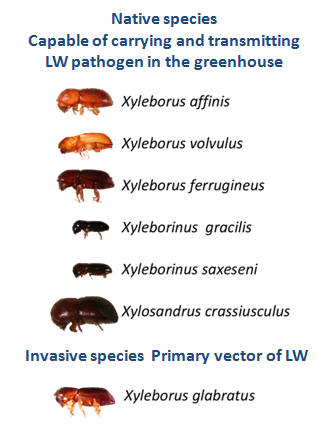
List of ambrosia beetles capable of carrying the LW pathogenAmbrosia beetles are small, elongate, cylindrical, fungus farmer beetles about 2 mm in length. They have obligate nutritional relationships with fungi that grow in their natal galleries in host-tree xylem (Six, 2012). Their larval stages feed upon these fungi until they reach the adult stage, which in turn carries the fungal symbionts from tree to tree in specialized structures called mycangia. Several native and exotic ambrosia beetle species are found in Florida (Carrillo et al. 2012). The exotic redbay ambrosia beetle Xyleborus glabratus Eichhoff has become established in the southeastern U.S during the last decade. This beetle attacks healthy trees in the Lauraceae and vectors the lethal fungus, Raffaelea lauricola, to native trees in southern Florida such as redbay (Persea borbonea) and swampbay (P. palustris), and the economically important commercial avocado (P. americana) . The pathogen causes a disease named laurel wilt and symptoms usually develop within 4 to 8 weeks of infection and include wilting, desiccation, dieback of stems and limbs and tree death.To date very few redbay ambrosia beetles have been detected in the commercial avocado production area (Carrillo et al., 2012; Carrillo et al., 2013). Recently, however, the LW pathogen has been found in or on at least 7 other ambrosia beetles present in south Florida, two of which (Xyleborus volvulus and Xyleborus ferrugineus) have been demonstrated under greenhouse conditions capable of transmitting R. lauricola to avocado trees (Carrillo et al., 2014). This disease is threatening the commercial avocado industry in South Florida.
-
Damage
Part of plant damaged: Trunk
Ambrosia beetles burrow into tree trunks, stems and branches. Infested trees are regularly stressed before the attack, but frequently the trees appear to be healthy and vigorous. -
Management
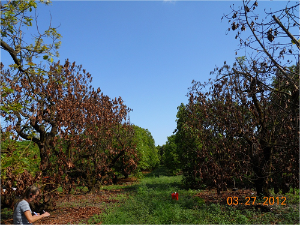
Avocado trees killed by laurel wiltThe largest portion of the ambrosia beetle population is found inside infested trees. Contact insecticides have not been shown to prevent ambrosia beetle emergence from already infested trees or wood and only a few contact insecticides have been found to provide good control of ambrosia beetles on wood surfaces. Chipping and burning wood can eliminate ambrosia beetles inside tree stumps and wood and stop their reproduction. However, to kill ambrosia beetles outside of the tree stumps and wood, applications of contact insecticides and/or biopesticides are recommended to help control or prevent further beetle movement in the grove (e.g., Malathion, Danitol or Hero), plus adjuvant (i.e., NuFilm, Vapor Gard or Pentrabark). Some biopesticides (e.g., BotaniGard) have also shown promise as detrimental to ambrosia beetles. Avocado groves under organic production should chip and burn all wood (including the chips). Detailed recommendations for ambrosia beetle and laurel wilt pathogen control are presented below.
Fact Sheets
- Laurel Wilt Control Recommendations
- Updated list of insecticides labeled for Florida avocado production
- Carrillo, D., Crane, J. H., Peña, J. E. 2013a. Potential of contact insecticides to control Xyleborus glabratus (Coleoptera: Curculionidae), a vector of laurel wilt disease in avocados. J. Econ. Entomol. 106(6): 2286-2295.
- Carrillo, D., Kendra, P.E., Duncan, R. E., Montgomery, W. S., Peña, J. E. 2013b. Evaluation of insect repellents to manage the redbay ambrosia beetle, vector of laurel wilt, a lethal disease affecting avocados in Florida. Florida Entomological Society, 96th Annual Meeting Presentation Abstract. Naples, Florida; 14-17 July.
- Kuhns, E. H., Tribuiani, Y., Martini, X., Meyer, W. L. Peña, J., Hulcr, J. and Stelinski, L. L. 2013. Volatiles from the symbiotic fungus Raffaelea lauricola are synergistic with manuka lures for increased capture of the Redbay ambrosia beetle Xyleborus glabratus. Agricultural and Forest Entomology, DOI: 10.1111/afe. 12037.
- Brar, G. S., Capinera, J. L., Mclean, S., Kendra, P. E., Ploetz, R. C., Peña, J. E. 2012. Effect of trap size, trap height and age of lure on sampling Xyleborus glabratus (Coleoptera: Curculionidae: Scolytinae), and its flight periodicity and seasonality. Florida Entomol. 95(4): 1003-1011.
- Carrillo, D., Duncan, R. E., Peña, J. E. 2012. Ambrosia beetles (Coleoptera: Curculionidae: Scolytinae) that breed in avocado wood in Florida. Florida Entomol. 95(3): 573-579.
- Peña, J. E., Carrillo, D., Duncan, R. E., Capinera, J. L., Brar, G., Mclean, S., Arpala. M. L., Focht, E. Smith, J. A., Hughes, M., Kendra, P.E. 2012. Susceptibility of Persea spp. and other Lauraceae to attack by redbay ambrosia beetle, Xyleborus glabratus (Coleoptera: Curculionidae: Scolytinae). Florida Entomol. 95(3): 783-787.
- Peña, J. E., Crane, J. H., Capinera, J. L., Duncan, R. E., Kendra, P.E., Ploetz, R. C., Mclean, S., Brar, G., Thomas, M. C., Cave, R. D. 2011. Chemical control of the redbay ambrosia beetle, Xyleborus glabratus, and other Scolytinae (Coleoptera: Curculionidae). Florida Entomol. 94(4): 882-896.
- Crane, J. H., Peña, J. 2008. Redbay ambrosia beetle - laurel wilt fungus: a potential major problem for Florida avocados. University of Florida, IFAS Extension, EDIS, 7 pp. HS1136. http://edis.ifas.ufl.edu/hs379.
- Mayfield III, A. E., Peña, J. E., Crane, J. H., Smith, J. A., Branch, C. L., Ottoson, E. D., Hughes, M. Ability of the redbay ambrosia beetle (Coleoptera: Curculionidae: Scolytinae) to bore into young avocado (Lauraceae) plants and transmit the laurel wilt pathogen (Raffaelea sp.). Florida Entomol. 91(3): 485-487.
-
Images
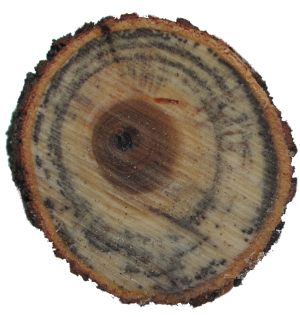
Sapwood discoloration due to laurel wilt
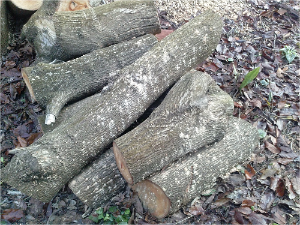
Avocado logs, a major source of ambrosia beetles
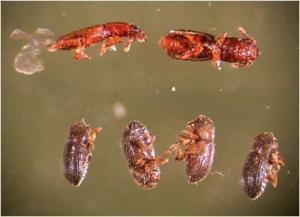
Adults of ambrosia beetles
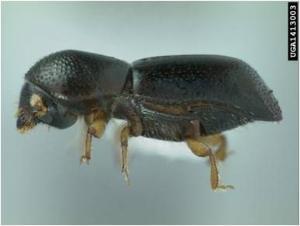
Adult female of Xyleborus glabratus
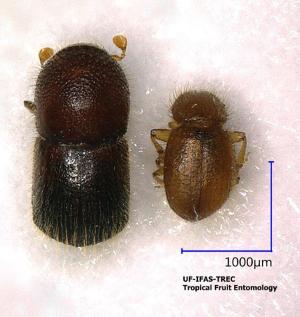
Xylosandrus crassiusculus female (left), male (right)
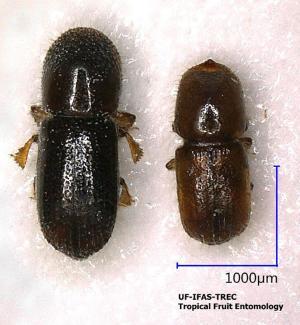
Xyleborus affinis female (left), male (right)
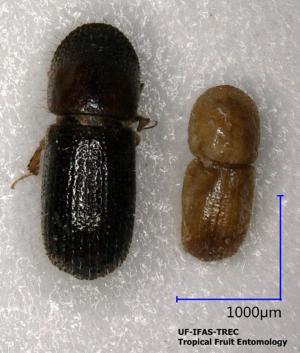
Xyleborus volvulus female (left), male (right)
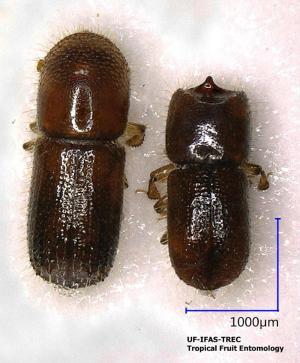
Xyleborus bispinatus female (left), male (right)
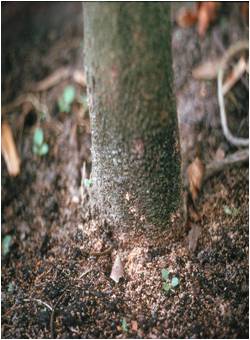
Frass exuding from avocado trunks infested with ambrosia beetles
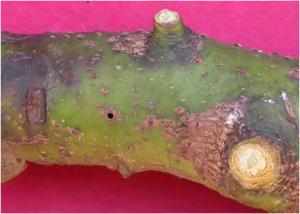
Holes on avocado trunks infested with ambrosia beetles
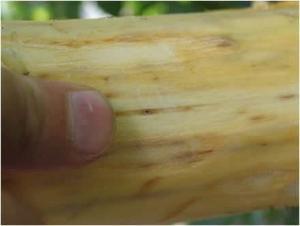
Holes on avocado trunks infested with ambrosia beetles
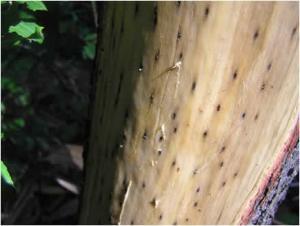
Holes on avocado trunks infested with ambrosia beetles
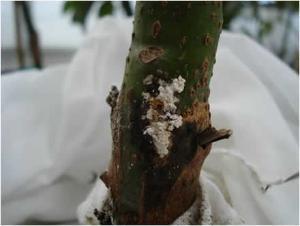
Sugary secretions on avocado trunks infested with ambrosia beetles

